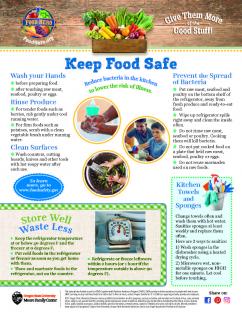Keep Food Safe
Reduce bacteria in the kitchen to lower the risk of illness.
Wash your Hands
- before preparing food.
- after touching raw meat, seafood, poultry or eggs.
Rinse Produce
- For tender foods such as berries, rub gently under cool running water.
- For firm foods such as potatoes, scrub with a clean vegetable brush under running water.
Clean Surfaces
- Wash counters, cutting boards, knives and other tools with hot soapy water after each use.
Prevent the Spread of Bacteria
- Put raw meat, seafood and poultry on the bottom shelf of the refrigerator, away from fresh produce and ready-to-eat food.
- Wipe up refrigerator spills right away and clean the inside often.
- Do not rinse raw meat, seafood or poultry. Cooking them will kill bacteria.
- Do not put cooked food on a plate that held raw meat, seafood, poultry or eggs.
- Do not reuse marinades used on raw foods.
To learn more, go to www.foodsafety.gov
Kitchen Towels and Sponges
Change towels often and wash them with hot water. Sanitize sponges at least weekly and replace them often.
Here are 2 ways to sanitize:
1) Wash sponges in the dishwasher using a heated drying cycle.
2) Microwave wet, nonmetallic sponges on HIGH for one minute. Let cool before touching.
Store Well Waste Less
- Keep the refrigerator temperature at or below 40 degrees F and the freezer at 0 degrees F.
- Put cold foods in the refrigerator or freezer as soon as you get home with them.
- Thaw and marinate foods in the refrigerator, not on the counter.
- Refrigerate or freeze leftovers within 2 hours (or 1 hour if the temperature outside is above 90 degrees F).
Cook and Serve Food Safely
Skillet-Braised Chicken
Quick Chicken Rice Soup
Tips for Using a Food Thermometer:
- Put the thermometer in the middle of the thickest part of the food, making sure it does not touch the cooking dish or any bone.
- Find the safe cooking temperature of foods in the table below.
- Wash the thermometer after each use with hot, soapy water.
- Check your thermometer each month by putting it in ice water to see if it reads 32 degrees F. If it does not, look for manufacturer directions that may tell you how to adjust it.
Cook to at least the temperature listed:
Beef, pork and lamb: 145 degrees F
Ground beef, pork and lamb: 160 degrees F
Egg dishes: 160 degrees F
Chicken, turkey and other poultry: 165 degrees F
Casseroles and leftovers: 165 degrees F
Kids Can!
While kids help make healthy food, they can learn about food safety. Kids can:
- find the food safety directions in these recipes. (Hint: there are 6.)
- prevent the spread of bacteria by following the food safety directions in recipes.




